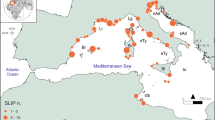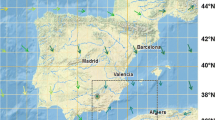Abstract.
A tree-ring chronology network recently developed from the subantarctic forests provides an opportunity to study long-term climatic variability at higher latitudes in the Southern Hemisphere. Fifty long (1911–1985), homogeneous records of monthly mean sea-level pressure (MSLP) from the southern latitudes (15–65 °S) were intercorrelated on a seasonal basis to establish the most consistent, long-term Trans-Polar teleconnections during this century. Variations in summer MSLP between the South America-Antarctic Peninsula and the New Zealand sectors of the Southern Ocean are significantly correlated in a negative sense (r=−0.53, P<0.001). Climatically sensitive chronologies from Tierra del Fuego (54–55°) and New Zealand (39–47°) were used to develop verifiable reconstructions of summer (November to February) MSLP for both sectors of the Southern Ocean. These reconstructions, which explain between 37 and 43% of the instrumentally recorded pressure variance, indicate that inverse trends in MSLP from diametrically opposite sides of Antarctica have prevailed during the past two centuries. However, the strength of this relationship varies over time. Differences in normalized MSLP between the New Zealand and the South America-Antarctic Peninsula sectors were used to develop a Summer Trans-Polar Index (STPI), which represents an index of sea-level pressure wavenumber one in the Southern Hemisphere higher latitudes. Tree-ring based reconstructions of STPI show significant differences in large-scale atmospheric circulation between the nineteenth and the twentieth centuries. Predominantly-negative STPI values during the nineteenth century are consistent with more cyclonic activity and lower summer temperatures in the New Zealand sector during the 1800s. In contrast, cyclonic activity appears to have been stronger in the mid-twentieth than previously for the South American sector of the Southern Ocean. Recent variations in MSLP in both regions are seen as part of the long-term dynamics of the atmosphere connecting opposite sides of Antarctica. A detailed analysis of the MSLP and STPI reconstructions in the time and frequency domains indicates that much of the interannual variability is principally confined to frequency bands with a period around 3.3–3.6 y. Cross spectral analysis between the STPI reconstruction and the Southern Oscillation Index suggests that teleconnections between the tropical ocean and extra-tropical MSLP variations may be influencing climate fluctuations at southern latitudes.
Similar content being viewed by others
Author information
Authors and Affiliations
Additional information
Received: 18 December 1996/Accepted: 10 January 1997
Rights and permissions
About this article
Cite this article
Villalba, R., Cook, E., D’Arrigo, R. et al. Sea-level pressure variability around Antarctica since A.D. 1750 inferred from subantarctic tree-ring records. Climate Dynamics 13, 375–390 (1997). https://doi.org/10.1007/s003820050172
Issue Date:
DOI: https://doi.org/10.1007/s003820050172




